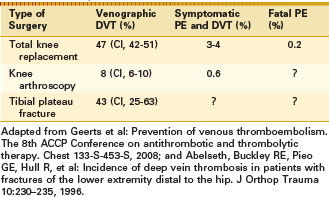Chapter 138 Venous Thromboembolism Prophylaxis After Knee Surgery
The European Approach
In Europe, an ever-increasing number of total knee replacements, and countless arthroscopic procedures and other periarticular knee procedures, are performed each year. The risk of thromboembolism must be considered (Table 138-1)1,5 and appropriate prophylaxis applied.
There is no universal approach across Europe. Every country, every hospital, and indeed every individual surgeon will have their own strategy based on their philosophy, their experience, and their resources. There are guidelines in some countries that may or may not be followed (Box 138-1). Some countries have universally accepted practices (e.g., low-molecular-weight heparin [LMWH] use in France) whereas in other countries there is a wide range of practice and much controversy (e.g., United Kingdom). However, it is generally believed that warfarin is obsolete and aspirin is inadequate (Box 138-2).
Box 138-1
Dutch recommendations adapted from www.cbo.nl; German recommendations adapted from Prophylaxis of venous thromboembolism. Eur J Vasc Endovasc Surg Vasc Med 38:1–132, 2009; French recommendations adapted from Samama CM, Albaladejo P, Benhamou D, et al; Committee for Good Practice Standards of the French Society for Anaesthesiology and Intensive Care (SFAR): venous thromboembolism prevention in surgery and obstetrics: clinical practice guidelines. 23:95–116, 2006; Italian recommendations adapted from Laziosanità-Agenzia Di Sanità Pubblica: 20__ (http://www.asplazio.it/); Swedish recommendations adapted from the Swedish Health Department: 2004.
European Guidelines
British Recommendations13
French Recommendations
Elective Knee Replacement: LMWHs are the standard preventive treatment after (grade A).
Aspirin should not be considered as a prophylactic measure for VTE (grade B).
Italian Recommendations
Knee arthroscopy: No prophylaxis routinely. If risk factors present, then consider LMWH.
Box 138-2 Drawbacks of Warfarin and Aspirin
Drawbacks of Warfarin
Effect of Prophylaxis After Knee Arthroscopy
The effect of prophylaxis after knee arthroscopy has not been clearly established.15 Meta-analyses have suggested that LMWH reduces the incidence of distal deep vein thrombosis (DVT) diagnosed by sonography after knee arthroscopy (Table 138-2). However, the clinical benefit of this is uncertain; the number needed to harm is only 20. There is a mixed effect and no clear stratification for individual risk or complexity of procedure There is insufficient evidence to conclude that thromboprophylaxis is effective in preventing thromboembolic events safely in people with unknown risk factors for thrombosis who are undergoing knee arthroscopy.
Stay updated, free articles. Join our Telegram channel

Full access? Get Clinical Tree










